Telangana TSBIE TS Inter 1st Year Botany Study Material 4th Lesson Plant Kingdom Textbook Questions and Answers.
TS Inter 1st Year Botany Study Material 4th Lesson Plant Kingdom
Very Short Answer Type Questions
Question 1.
What is the basis of classification of Algae?
Answer:
- Pigmentation and the type of stored food are the basis for classification of algae.
- Based on above criteria algae are divided into 3 main classes-chlorophyceae Phaeophyceae and Rhodophyceae.
Question 2.
When and where does reduction division take place in the life cycle of a liverwort, a moss, a fern, a gymnosperm and an angiosperm?
Answer:
- Liverwort – Sporophyte (capsule) – spore mother cell.
- Moss – Sporophyte (capsule) – spore mother cells.
- Gymnosperm – Sporophyte (Micro and mega sporangia) – Micro and megaspore
- Angiosperm – Sporophyte (Anthers and ovule) – Spore mother cells
Question 3.
Differentiate between syngamy and triple fusion.
Answer:
1) Syngamy :
One of the two male gametes released from pollen tube fuses with the egg cell to form a diploid zygote. This is also called true or real fertilisation.
2) Triple fusion :
One of the two male gametes released from pollen tube fuses with the diploid secondary nucleus to produce the triploid Primary Endosperm Nucleus (PEN).
Question 4.
Differentiate between antheridium and archegonium.
Answer:
- The antheridium is male sex organ whereas archegonium is female sex organ.
- Antheridium produces many antherozoids (sperms), while archegonium produces an egg cell.
Question 5.
What are the two stages found in the gametophyte of mosses? Mention the structures from which these two stages develop?
Answer:
- Protonema and Gametophore.
- Protonema develops directly from the spore and adult gametophore develops from protenema.
![]()
Question 6.
Name the stored food materials found in Phaeophyceae and Rhodophyceae. [May ’14]
Answer:
- The stored food materials found in Phaeophyceae are laminarin or mannitol.
- The stored food material found in Rhodophyceae is floridian starch.
Question 7.
Name the pigments responsible for brown colour of Phaeophyceae and red colour of Rhodophyceae.
Answer:
- The brown colour of Phaeophyceae depends upon the amount of xanthophyll pigment, fucoxanthin present in it.
- The red colour of Rhodophyceae is due to red pigment r – phycoerythrin.
Question 8.
Name different methods of vegetative reproduction in Bryophytes. [Mar. 15 – A.P.]
Answer:
Fragmentation, gemmae and budding.
Question 9.
Name the integumented megasporangium found in Gymnosperms. How many female gametophytes are generally formed inside the megasporangium?
Answer:
- Ovule
- One female gametophyte with 2 or more archegonia is formed inside the megasporangium.
Question 10.
Name the Gymnosperms which contain mycorrhiza and corolloid roots respectively.
Answer:
- Pinus contains mycorrhizal roots.
- Cycas, contains corolloid robts.
Question 11.
Mention the ploidy of any four of the following.
a) Protonemal cell of a moss
b) Primary endosperm nucleus in a dicot
c) Leaf cell of a moss
d) Prothallus of a fern
e) Gemma cell in Marchantia
f) Meristem cell of monocot
g) Ovum of a liverwort
h) Zygote of a fern.
Answer:
a) Haploid
b) Triploid
c) Haploid
d) Haploid
e) Haploid
f) Diploid
g) Haploid
h) Diploid
Question 12.
Name the four classes of Pteridophyta with one example each.
Answer:
Cl : Psilopsida Ex : Psilotum
Cl: Lycopsida Ex : Selaginello, Lycopodium
Cl : Sphenopsida Ex : Equisetum
Cl : Pteropsida Ex : Dryopteris, Pteris, Adiantum
Question 13.
What are the first organisms to colonise rocks? Give the generic name of the moss which provides peat.
Answer:
- Mosses and lichens are the first organisms to colonise rocks
- Sphagnum, (a moss) provides peat.
Question 14.
Mention the fern characters found in Cycas.
Answer:
Fern characters found in Cycas are
- Young leaves exhibit circinate vernation.
- Presence of ramenta.
- Male gametes are multiciliated.
- Archegonia are present in the female gametophyte.
Question 15.
Why are Bryophytes called the amphibians of the plant kingdom?
Answer:
Bryophytes are called the amphibians of the plant kingdom because these plants live in moist soil and are dependent on water for sexual reproduction.
Question 16.
Name an algae which show
a) Haplo-diplontic and
b) Diplontic types of life cycles.
Answer:
a) Ectocarpus and Kelps (Laminaria) – haplo-diplontic life cycle.
b) Fucus – diplontic life cycle.
![]()
Question 17.
Give examples for unicellular, colonial and filamentous algae.
Answer:
Unicellular algae Ex : Chlamydomonas.
Colonial algae Ex : Volvox
Filamentous algae Ex : Spirogyra, Ulothrix.
Short Answer Type Questions
Question 1.
Differentiate between red algae and brown algae. [Mar. ’14]
Answer:
| Red algae | Brown algae |
| a) Members of Rhodophyceae are commonly called red algae. | a) Members of Phaeophyceae are commonly called brown algae. |
| b) They possess chlorophyll a, d, and phycoerythrin. | b) They posses chlorophyll a, c, carotenoids, and xanthophyll. |
| c) Red colour is due to Phycoerythrin pigment. | c) Brown colour is due to xanthophyll pigment. |
| d) Reserve food material is in the form of Floridean starch. | d) Reserve food material is in the form of mannitol (or) laminaria. |
Question 2.
Differentiate between liverworts and mosses.
Answer:
| Liverworts | Mosses |
| 1) They have a thallus-like dorsoventrally flattened body. | 1) These are differentiated into stem-like and leaf-like structures. |
| 2) Rhizoids unicellular. | 2) Rhizoids multicelluar and branched. |
| 3) Sporangium is differentiated into foot, seta and capsule. In some cases foot and seta may be absent. | 3) Sporangium is differentiated into foot, seta and capsule. |
| 4) Sporangium does not synthesise its food. | 4) The sporangium synthesise its own food. |
| 5) Elaters in the capsule help in spore dispersal. | 5) Peristomial teeth help in spore dispersal. |
| 6) Columella lacking | 6) Columella is found. |
| 7) Protonema and gametophore are absent. | 7) Gametophyte has two stages. They are 1) Protonema 2) Gametophore. |
![]()
Question 3.
What is meant by homosporous and heterosporous pteridophytes? Give two examples.
Answer:
The plants which produce only one kind of spores are called homosporous Ex: Psilotum, Lycopodium. The plants which produce two kinds of spores, macro or megaspores and microspores are called heterosporous Ex: Selaginella, Salvinia.
Question 4.
What is heterospory? Briefly comment on its significance. Give two examples.
Answer:
Producing two types of spores is called heterospory 1) Microspores 2) Megaspores.
Significance :
In heterosporous plants, the megaspores and microspores germinate and give rise to female and male gametophyte respectively. Male gametes are transferred to the egg of female archegonium. The female gametophytes retain on the parent sporophyte for variable period. The development of zygotes into young embryos takes place within the female gametophytes. This event is a precursor to the seed habit. It is considered as an important step in evolution.
Example : Selaginella and salvinia.
Question 5.
Write a note on economic importance of Algae and Bryophytes. [March 2019]
Answer:
Economic importance of Algae :
- About 50% of carbon fixation is done by algae by photosynthesis. Thus by photosynthesis 02 is released into environment.
- Algae are primary producers for all aquatic animals in food cycle.
- Many species of Porphyra, Laminaria and Sargassum are among the 70 species of marine algae used as food.
- Brown algae and Red algae produce large amounts of hydrocolloids (water holding substances) & algin (brown algae) and carrageen (red algae) which are used commercially.
- Agar obtained from Gelidium and Gracilaria is used to grow microbes and preparations of ice-creams and jellies.
- Iodine is extracted from kelps like Laminaria.
- Chlorella and Spirullina are unicellular algae used as food supplements even by space travellers.
Economic importance of bryophytes (mosses) :
- Mosses provide food for herbaceous mammals, birds and other animals.
- Sphagum provides peat used as fuel, because of its water holding capacity, they are used as packing material for trans-shipment of living material.
- Mosses along with lichens are the first organisms to colonise rocks and hence they have great ecological importance.
- They decompose rock making it suitable for the growth of higher plants, hence, they play important role in plant succession.
- Mosses form dense mats on the soil, they reduce the impact of falling rain and prevent soil erosion.
Question 6.
How would you distinguish Monocots from Dicots?
Answer:
| Monocots | Dicots |
| 1) Monocot seeds have one cotyledon. | 1) Dicot seeds have two cotyledons. |
| 2) Adventitious root system is present. | 2) Tap root system is present. |
| 3) Leaves show parallel venation | 3) Leaves show reticulate venation. |
| 4) Sheathing leaf base is present. | 4) Sheathing leaf base is absent. |
| 5) Leaves are isobilateral. | 5) Leaves are dorsiventral. |
| 6) Secondary growth is absent. | 6) Secondary growth takes place. |
![]()
Question 7.
Give a brief account of prothallus. [Mar. – 2020]
Answer:
- Haploid spores give rise to gametophytic prothallus in pteridophytes.
- Prothallus is small, thin, green and autotrophic thallus like structure.
- Prothallus grows in cool, damp, shady places as it requires water for fertilization.
- Prothallus bears sex organs. The male sex organs are called antheridia and the female sex organs are called archegonia.
- These sex organs are multicellular, jacketed and sessile.
- Antheridia produce male gametes called antherozoids. Archegonia has egg cell which is a female gamete.
- Antherozoids require water to reach egg.
- Zygote develops into embryo within the female gamete. This event is a precursor to the seed habit. It in considered as an important step in evolution.
Question 8.
Draw labelled diagrams of
a) Female thallus and male thallus of a liverwort
b) Gametophyte and sporophyte of Funaria.
Answer:
a)
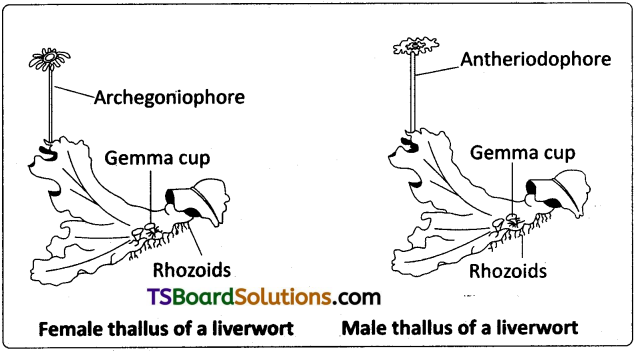
b)
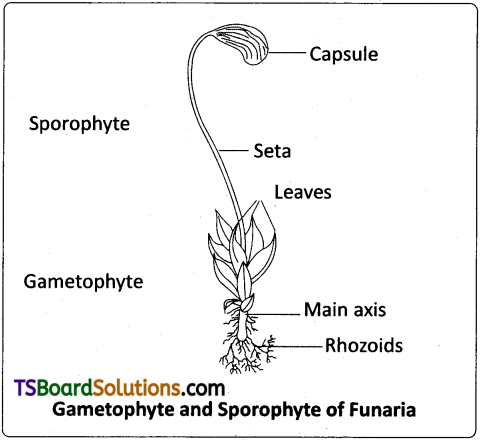
Long Answer Type Questions
Question 1.
Name three groups of plants that bear archegonia. Briefly describe the life cycle of any one of them.
Answer:
Bryophytes, pteridophytes and gymnosperms bear archegonia.
Life cycle of a Moss plant:
- The gametophyte is a dominant phase.
- Moss plant is a haploid gametophore.
- It produces gametangia on separate branches of the same plant and hence monoecious.
- The club shaped antheridia or antheridial branches produce biflagellate male gametes called “antherozoids”.
- The flask shaped archegonia on archegonial branches produce eggs (female gamete) in their venter.
- Antherozoids liberated swim in water to reach egg in the venter.
- Union of one male gamete (antherozoid) and egg unite results in diploid zygote. This is called fertilization.
- Zyeote is the first cell for sporophytic generation. Zygote develops into embryo. Embryo is retained within the archegonium.
- It develops into semi parasitic sporophyte consisting of foot, seta and capsule.
- The spore mother cells in the spore sac of the capsule undergo meiosis and forms a number of haploid spores of one kind. Hence Funaria is homosporous.
- Spore is the first cell for gametophytic generation under favourable conditions, the spore liberated germinates to give rise to filamentous protonema.
- The buds arising from the aerial branches of protonema develop into independent gametophores.
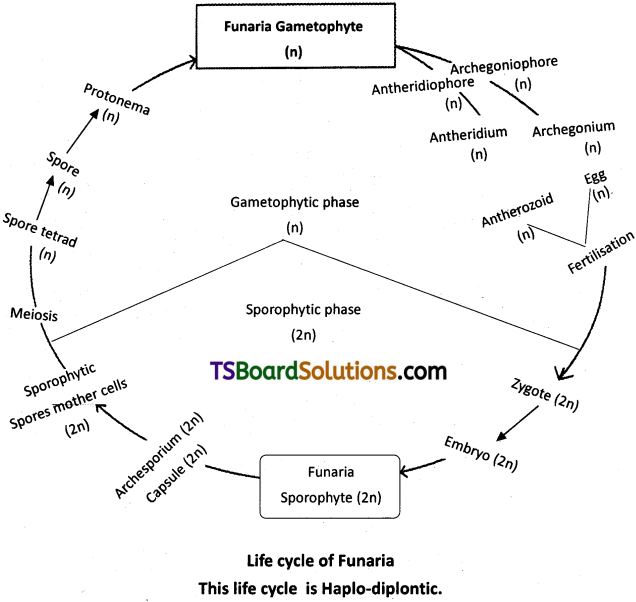
Question 2.
Describe the important characteristics of Gymnosperms.
Answer:
The important characters of Gymnosperms are :
- All gymnosperms are perennial, growing as woody trees or bushy shrubs.
- Vascular tissues are arranged into vascular bundles.
- Flowers are absent, however, microsporophylls and megasporophyll usually aggregate to form distinct cones or strobili called male cones and female cones respectively.
- Gymnosperms are heterosporous: Gymnosperms produce two types of spores- Microspores and megaspores. Microspores are produced in Microsporangium. They are called pollen grain. Megaspores are produced in Megasporangia. The megasporangia are integumented and are called ovules.
- Ovules are borne on megasporophyll and have three layered integument with an opening called micropyle.
- Pollination is indirect.
- Fertilization is affected by pollen tube produced by the male gametophyte. It is called siphonogamy.
- Endosperm is formed before fertilization. That means female gametophyte is considered as endosperm. It is haploid.
- Seeds are naked i.e., without any seed coat.
![]()
Question 3.
Give the salient features of pteridophytes.
Answer:
- The main plant body of pteridophyte is sporophyte. It is differentiated into true roots, stem and leaves.
- Vascular tissues are present. So pteridophytes are commonly called vascular cryptogams.
- Roots are adventitious.
- Stem is underground rhizome.
- The leaves of pteridophytes are small (microphyllous) as in selaginella or large fronds (macrophyllous) as in ferns.
- Ferns show circinate vernation and the petioles are covered with brown multicellular hairs called ramenta.
- The stele may be protostele or siphonostele or solenostel6.
- One of the important characters of pteridophyte is that the sprophyte has become the dominant part of the life cycle while the gametophyte is reduced.
- Gametophyte is small and inconspicuous and it is produced from haploid spores known as prothallus.
- The asexual generation or the sporophyte may be homosporous (all spores are similar) or heterosporous (two different types of spores) i.e., microspores or megaspores.
- Prothallus (gametophytes) are monoecicus or dioecious.
- Sex organs are Antheridia and Archegonia.
- Male gametes are Antherozoids formed from Antheridia. Antherozoids are uninucleate, spirally coiled, biflagellate or multiflagellate structures.
- Union of male gamete and female gamete results in diploid zygote.
- Zygote develops into Embryo stage.
- True fruit and seeds are not formed at any stage.
Question 4.
Give an account of plant life cycles and alternation of generations.
Answer:
Plant life cycles :
1) Haplontic type of life cycle :
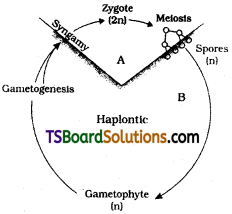
- The dominant phase is gametophyte. It is photosynthetic free living.
- Sporophytic generation is represented by zygote.
- Zygote is a resting stage not a free living sporophyte.
- Thus the life cycle having only free living gametophyte without free living sporophyte is called Haplontic type of life cycle. Ex :Algae like chlamydomonas, Volvox, Spirogyra etc.
2) Diplontic type of life cycle :
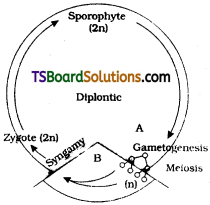
- The dominant phase is sporophyte. It is photosynthetic independent plant.
- Gametophytic generation is represented by gametes.
- Thus the life cycle having only independent sporophyte without gametophyte is called Diplontic type of life cycle.
- The life cycle having only independent sporophyte with few celled or many celled staged gametophyte is called diplo-haplontic type of life cycle.
Ex: Pteridophytes and seed-bearing plants.
3) Haplo-diplontic type of life cycle :
- The dominant phase is gametophytic generation. It is independent.
- Sporophytic generation is photosynthetic dependent on gametophytic generation.
- The life cycle having both dominant gametophytic generation and dependent sporophytic generation is called Haplo-diplontic type.
Interestingly most algae are haplontic. Some such as Ectocarpus and kelps are haplo-diplontic. Fucus is diplontic and Polysiphonia is diplo-biontic.
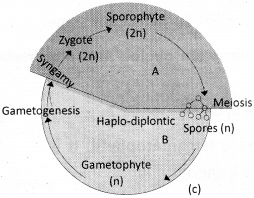
Alternation of generations:
- In the life cycle of an organism two phases are present. They are Gametophytic phase and Sporophytic phase.
- Haploid spore is the first cell for gametophytic generation.
- Haploid spore divides mitotically and forms haploid gametophyte.
- Gametophyte shows sexual reproduction. It forms male and female gametes.
- The fusion of male and female gametes results in diploid zygote.
- Diploid zygote is the first cell for sporophytic generation.
- Diploid zygote divides mitotically and forms diploid sporophyte.
- Diploid sporophyte shows asexual reproduction. It undergoes meiosis and forms haploid spores.
Thus during the life cycle of plants gamete producing haploid gametophyte alternates with spore producing diploid sporophyte. This is known as alternation of generation.
![]()
Question 5.
Both Gymnosperms and Angiosperms bear seeds, then why are they classified separately?
Answer:
Even though both Gymnosperms and Angiosperms bear seeds, they are classified separately because of nature of seeds.
In Gymnopserms:
- The plant bears ovules which are not covered by any ovary wall. They remain exposed.
- Pollination is direct.
- Seeds formed are not covered by seed-coat. They are naked seeded plants.
- Female gametophyte is considered as Endosperm as it is nutritive in function.
- Endosperm is formed before fertilisation.
- It is haploid.
- Poly embryonic condition is present.
In Angiosperms:
- The plant bears ovules which are present inside the ovary. They are not exposed.
- Pollination is indirect.
- Seeds formed are covered by seed – coat. They are closed seeded plants.
- Endosperm is formed after double fertilisation and triple fusion.
- Endosperm is triploid.
- Single embryo is present.
Intext Question Answers
Question 1.
How far does SelagineJIa, one of the few living members of Lycopodiales (Pteridophytes) fall short of seed habit.
Answer:
Selaginella is heterosporous. It produces two kinds of spores. They are macrospores and microspores. Macrospores germinate and give rise to female gametophyte whereas Microspores give rise to male gametophyte. Fusion of male gamete with the egg present in the archegonium results in the formation of Zygote. The development of zygotes into young embryos takes place with the female gametophyte. This is the precusor to the seed habit.
Question 2.
Each plant or group of plants has some phylogenetic significance in the relation of evolution. Cycas, one of few living members of Gymnosperms is called as the “relic of past”. Can you establish a phylogenetic relationship of Cycas with any other group of plants that justifies the above statement?
Answer:
Cycas, one of Gymnosperms shows close resemblance with fern (pteridophyte) on one hand and angiosperms on the other hand. Thus occupying a position intermediate between the two.
Certain primitive characters in cycas are similar to ferns. They are
- Stem when young is underground and subterranean.
- Leaf bases are persistent on the stem.
- Young leaves show circinate vernation.
- The sporophylls are leaf-like.
- Ramenta are present.
- Xylem consists of tracheids only and there are no vessels.
- Phloem lacks companion cells.
- Microsporangia occur in sori on the abaxial side of microsporophyll.
- Archegonia are still retained in the female gametophyte.
- Sperms are multiciliate.
Question 3.
The male and female reproductive organs of several pteridophytes and Gymnosperms are comparable to floral structures of angiosperms. Make an attempt to compare the various reproductive parts of Pteridophytes and Gymnosperms with reproductive structures of Angiosperms.
Answer:
| Reproductive structures of Pteridophytes are strobili or cone. | Reproductive structures of Gymnosperms are strobili or cone. | Reproductive structures of Angiosperms are flowers. |
| Cone is not differentiated as male cone and female cone. | Male cone and female cone are present. | Flowers may be unisexual as male flowers and female flowers. (or) Flowers may be bisexual. |
| Mostly homosporous Sporophylls bear sporangia which produce spores. Some are heterosporous Microsporophyll bearing Microsporangia produce Microspores. Macrosporophyll-bearing Macrosporangia produce Macrospores. | The male cone bearing Microsporophyll and Microsporangia are called microsporangiate or male strobili. (This is similar to male flower) They produce Microspores.
The female cone bearing Megasporophyll and Megasporophyll with ovule or integumented mega-sporangia are called megasporangiate or female strobili (This is similar to female flower) |
The male sex organs are called stamen or Microsprophyll.
Anther represents microsporangium. Pollengrains represent microspores. Female sex organ carpels represent Megasporophyll. Carpel is with ovule or integumented Megasporangia. |
![]()
Question 4.
The plant body in higher plants is well differentiated and well developed. Roots are organs used for the purpose of absorption. What are the equivalent of roots in the less developed lower plants?
Answer:
Rhizoids. They are unicellular or multicellular hair-like structures that penetrate the moist soil and absorb the water for the plants.